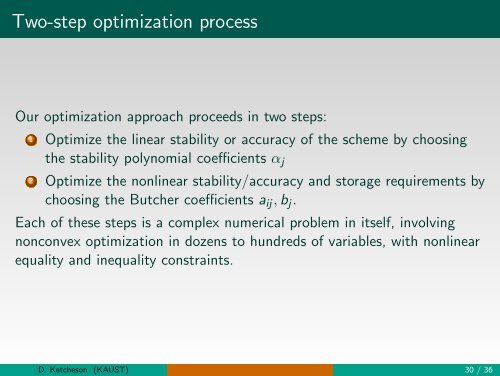Design of optimal Runge-Kutta methods - FEniCS Project
Design of optimal Runge-Kutta methods - FEniCS Project Design of optimal Runge-Kutta methods - FEniCS Project
Two-step optimization process Our optimization approach proceeds in two steps: 1 Optimize the linear stability or accuracy of the scheme by choosing the stability polynomial coefficients αj 2 Optimize the nonlinear stability/accuracy and storage requirements by choosing the Butcher coefficients aij, bj. Each of these steps is a complex numerical problem in itself, involving nonconvex optimization in dozens to hundreds of variables, with nonlinear equality and inequality constraints. D. Ketcheson (KAUST) 30 / 36
Optimizing for the SD spectrum On regular grids, SD leads to a block-Toeplitz operator We perform a von Neumann-like analysis using a ”generating pattern” dWi,j dt i − 1,j i − 1,j+1 �g2 i − 1,j− 1 i, j − 1 i, j �g1 i, j +1 i +1,j+1 i +1,j− 1 a � 0,0 + T Wi,j + T ∆g −1,0 Wi−1,j + T 0,−1 Wi,j−1 +T +1,0 Wi+1,j + T 0,+1 � Wi,j+1 = 0 D. Ketcheson (KAUST) 31 / 36 i +1,j
- Page 1 and 2: Design of optimal Runge-Kutta metho
- Page 3 and 4: Outline 1 High order Runge-Kutta me
- Page 5 and 6: Solution of hyperbolic PDEs The fun
- Page 7 and 8: Solution of hyperbolic PDEs The fun
- Page 9 and 10: Solution of hyperbolic PDEs The fun
- Page 11 and 12: Time Integration Using a better tim
- Page 13 and 14: Time Integration Using a better tim
- Page 15 and 16: Time Integration Using a better tim
- Page 17 and 18: Runge-Kutta Methods To solve the in
- Page 19 and 20: Outline 1 High order Runge-Kutta me
- Page 21 and 22: The Stability Function For the line
- Page 23 and 24: Absolute Stability For the linear e
- Page 25 and 26: Stability optimization This leads n
- Page 27 and 28: Stability Optimization: a toy examp
- Page 29 and 30: Stability Optimization: a toy examp
- Page 31 and 32: Stability Optimization: one more ex
- Page 33 and 34: Stability Optimization: one more ex
- Page 35 and 36: Nonlinear accuracy Besides the cond
- Page 37 and 38: Strong stability preservation Desig
- Page 39 and 40: Strong stability preservation Desig
- Page 41 and 42: The Forward Euler condition Recall
- Page 43 and 44: Runge-Kutta methods as a convex com
- Page 45 and 46: Example: A highly oscillatory flow
- Page 47 and 48: Low storage methods 3S Algorithm S3
- Page 49 and 50: Two-step optimization process Our o
- Page 51: Two-step optimization process Our o
- Page 55 and 56: Optimizing for the SD spectrum Prim
- Page 57 and 58: Application: flow past a wedge Dens
Two-step optimization process<br />
Our optimization approach proceeds in two steps:<br />
1 Optimize the linear stability or accuracy <strong>of</strong> the scheme by choosing<br />
the stability polynomial coefficients αj<br />
2 Optimize the nonlinear stability/accuracy and storage requirements by<br />
choosing the Butcher coefficients aij, bj.<br />
Each <strong>of</strong> these steps is a complex numerical problem in itself, involving<br />
nonconvex optimization in dozens to hundreds <strong>of</strong> variables, with nonlinear<br />
equality and inequality constraints.<br />
D. Ketcheson (KAUST) 30 / 36



